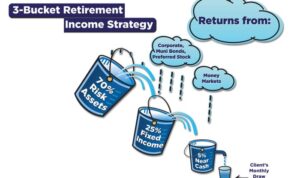Diving into the world of long-term investing opens up a realm of possibilities for building a solid financial future. From laying the groundwork for retirement to maximizing wealth growth, the journey of long-term investing is both strategic and rewarding.
As we delve deeper into the strategies and risks involved in long-term investing, the path to financial success becomes clearer and more achievable.
The Importance of Long-Term Investing

Investing for the long term is crucial for building wealth and achieving financial goals over time. It involves holding onto investments for an extended period, allowing them to grow and compound over the years.
Benefits of Long-Term Investing
- Compound Interest: By reinvesting your earnings, you can benefit from compound interest, which helps your investments grow exponentially over time.
- Reduced Risk: Long-term investors can ride out market fluctuations and volatility, reducing the impact of short-term market movements on their portfolio.
- Tax Efficiency: Holding onto investments for the long term can lead to lower tax rates on capital gains, compared to short-term trading.
- Time to Recover from Losses: Long-term investors have the advantage of time to recover from any temporary losses in the market, as investments have the opportunity to bounce back.
Financial Goals and Long-Term Investing
- Retirement Planning: Long-term investing is essential for building a retirement nest egg, as it allows your investments to grow steadily over decades, providing financial security in your golden years.
- Wealth Accumulation: By staying invested for the long term, you have the opportunity to accumulate significant wealth through the power of compounding and growth in the value of your investments.
- Education Funding: Long-term investing can also help you save for your children’s education or other major life expenses, providing a source of funds when needed in the future.
Strategies for Long-Term Investing
Investing for the long term requires careful planning and strategic decision-making to maximize returns and minimize risks. Let’s explore some key strategies for successful long-term investing.
Asset Allocation
Asset allocation is a crucial strategy for long-term investing, involving the distribution of investments across different asset classes such as stocks, bonds, and real estate. By diversifying your portfolio, you can reduce overall risk and potentially increase returns over time. It’s essential to find the right balance based on your risk tolerance and financial goals.
Dollar-Cost Averaging
Dollar-cost averaging is a strategy where you invest a fixed amount of money at regular intervals, regardless of market conditions. This approach helps smooth out market volatility and allows you to buy more shares when prices are low and fewer shares when prices are high. Over time, this strategy can lead to lower average costs per share and potentially higher returns.
Buy and Hold
The buy and hold strategy involves purchasing high-quality investments with the intention of holding onto them for an extended period, regardless of short-term market fluctuations. This approach requires patience and discipline but can be beneficial for long-term investors who believe in the fundamentals of their chosen investments.
Rebalancing
Rebalancing involves periodically reviewing and adjusting your investment portfolio to maintain the desired asset allocation. As market conditions change, certain asset classes may outperform or underperform, leading to a shift in your portfolio’s balance. By rebalancing, you can ensure that your investments align with your long-term goals and risk tolerance.
Diversification
Diversification is a key strategy for long-term investing that involves spreading your investments across different asset classes, industries, and geographic regions. This helps reduce the impact of market fluctuations on your overall portfolio and can enhance long-term returns. By diversifying, you can mitigate risk and potentially improve your chances of achieving your financial objectives.
Risk Management in Long-Term Investing
Investing for the long term comes with its fair share of risks, and it is crucial for investors to have a solid risk management strategy in place to protect their investments and achieve their financial goals.
Importance of Risk Management
- One key reason for implementing risk management in long-term investing is to minimize the impact of market volatility on your portfolio.
- By effectively managing risks, investors can avoid making impulsive decisions during market downturns, which could result in significant losses.
- Having a risk management plan in place provides a sense of security and peace of mind, allowing investors to stay focused on their long-term objectives.
Risk Mitigation Techniques for Long-Term Investors
- Diversification: Spreading your investments across different asset classes, industries, and geographic regions can help reduce the overall risk in your portfolio.
- Setting Stop-Loss Orders: Establishing predetermined price levels at which you will sell an investment can help limit potential losses in case of a market downturn.
- Regularly Rebalancing: Periodically reviewing and adjusting your investment portfolio to maintain your desired asset allocation can help manage risk over time.
Asset Allocation for Risk Management
Asset allocation is a critical component of risk management in long-term investing as it involves dividing your investment portfolio among different asset classes such as stocks, bonds, and cash equivalents based on your risk tolerance and investment goals.
It is essential to strike a balance between risk and return by allocating assets in a way that can help you achieve your financial objectives while managing potential risks effectively.
Monitoring and Adjusting Long-Term Investment Portfolios
When it comes to long-term investing, monitoring and adjusting your investment portfolio is crucial for ensuring continued growth and success. By keeping a close eye on your investments and making necessary adjustments, you can maximize your returns and stay on track towards your financial goals.
Importance of Regular Monitoring
Regularly monitoring your investment portfolio allows you to assess its performance and make informed decisions based on market trends and changes. It helps you identify areas that may need adjustment to optimize returns and minimize risks.
When to Adjust Your Long-Term Investment Strategy
Adjustments to your long-term investment strategy should be made when there are significant changes in your financial goals, risk tolerance, or market conditions. It’s essential to review your portfolio periodically and make changes accordingly to align with your objectives.
How to Stay Disciplined and Avoid Emotional Decision-Making
Staying disciplined in managing your long-term investments involves sticking to your predetermined investment plan and avoiding emotional reactions to market fluctuations. It’s important to focus on the long-term goals and not get swayed by short-term market volatility.






